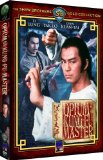| Reviews & Columns |
|
Reviews DVD TV on DVD Blu-ray 4K UHD International DVDs In Theaters Reviews by Studio Video Games Features Collector Series DVDs Easter Egg Database Interviews DVD Talk Radio Feature Articles Columns Anime Talk DVD Savant Horror DVDs The M.O.D. Squad Art House HD Talk Silent DVD
|
DVD Talk Forum |
|
|
| Resources |
|
DVD Price Search Customer Service #'s RCE Info Links |
|
Columns
|
|
|
Opium and the Kung Fu Master
Navarre Corporation Company // Unrated // January 6, 2009
List Price: $19.98 [Buy now and save at Amazon]
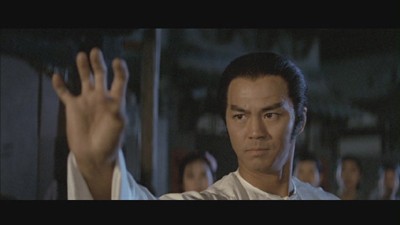
The Film:
It only takes around eleven to twelve (11-12) minutes to see how the Shaw Brothers' Opium and the Kung Fu Master quickly climbs up as a pertinent -- and underappreciated -- entry into late-'70s, early '80s kung-fu cinema. The intro seems simple enough: sagely kung-fu master Tieh Chiao-san (Ti Lung, A Better Tomorrow) hunts down and kills an opium-peddling thief in an elaborate hand-to-hand battle, reaffirming his status as both a beacon for the town and as a role model for his students. But as the natural high dwindles amid townsfolk appreciation, the teacher himself lights up a pipe and relaxes with opium behind closed doors. With the townspeople's eyes all on him and his students to purge the remaining thieves from the area, he's forced to struggle with weakness, addiction, and plummeting adoration along his path to redemption.
Opium and the Kung Fu Master follows along a familiar crash-and-rise "phoenix" arc within its ninety-three minutes, using historical China's opium addiction as its smoldering point. It's interesting to compare it to other addict-based films like Raging Bull and Walk The Line and see the similarities; as the master's fame escalates and his influence on the people around him strengthens, his destructive acts deconstruct those around him when he falters. Their liquid/substance "muse" helps to hone their craft, but ultimately becomes the crutch that supports their talent. Now, the Shaw Brothers picture isn't anywhere in the neighborhood of a dramatically-driven piece of work that's crafted to tap into emotion, but it's not without its levelheaded glimpses into addiction while it carries it audience from fight to fight in blueprint fashion.
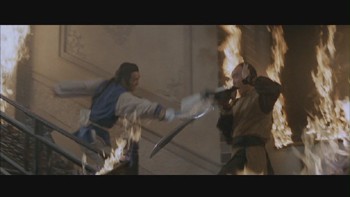 | 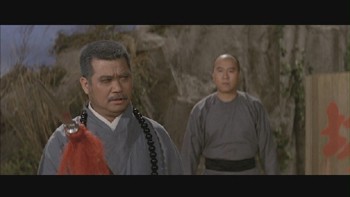 |
But, boy, the energetic choreography is absolutely top shelf in Opium and the Kung Fu Master, easily standing tooth-and-nail with 36th Chamber of Shaolin and other Shaw Brothers classics in both execution and lavishness. Action takes place in a wide range of interiors and exteriors, making ample use of environment to craft some awe-inspiring, labyrinthine moments. Two particular examples -- one being an opium warehouse scrap between the two rival factions, along with a large flaming building brawl shortly after -- broaden and manipulate their atmospheres to boundary-pushing levels, but never to a degree that completely ignores practicality. They also impeccably infuse humor and tension with the awe-inspiring choreography work in director Tang Chia's last film, creating an experience that leaves its audience captivated in a chuckling, bloodthirsty stupor.
Through these scenes, a lot of the film's understated-yet-intricate set design can be appreciated. With all the bodies flying about, as well as the Peckinpah-esque standoff glances between enemies, it's hard to notice exactly how pleasing the production design can be some of the Shaw productions. This one, in particular, exhibits great concentration on little aesthetics that give the audience bright allures to stare at. Opium and the Kung Fu Master even exhibits rudimentary, fun stabs at segmentation and symbolism with their art and costume design, like the color of the two faction's outfits and the ways that the master's clothing changes from simple, comfortable linens to constricting, tight blacks and grays as he plummets into dealing with the destructiveness of his addiction. It's all bookshelved with Ti Lung's performance as master Tieh Chiao-san, which carries the transitions in thematic content well with deftly-nailed exaggerated facial projections and body mannerisms.
Why Opium and the Kung Fu Master hasn't risen as a more revered and iconic champion among the Shaw Brothers films is beyond me, because it's one of their best, most resonant works among the masses. Virtually everything that you'd anticipate to come from the company's signature strategy makes an appearance in Opium, all in grand, iconic fashion. Two-man standoffs, twenty-man brawls, swordplay, staff play, and street throwdowns cram tightly into this picture like a festive clown car dressed to the nines in flashiness, yet they're all handled with that signature Shaw robustness that propel this feature to a surprisingly complete level. Opium and the Kung Fu Master has a blast with its kung-fu loving audience, but it never turns its back on restraint and filmic sobriety with its breakneck energy.
the DVD:
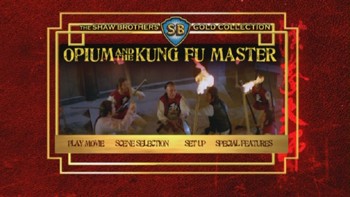 |  |
As one of the last BCI/Navarre corroborations, they're certainly going out with a bang by producing a phenomenal DVD for Opium and the Kung Fu Master. Presented in a clear-cased DVD, the coverart is actually reversible -- showing off a classy, embossed design on the front, and a more classic bootleg-style aesthetic on the reverse side. Inside, a lengthy set of Liner Notes accompanies the disc and artwork, discussing the Shaw Brother studio itself and the work "behind" and "Before" the camera for the film.
Video and Audio:
Stunningly rendered, this transfer is a robust, beautifully saturated, and grandly-detailed image that reveals everything that the production design used to create its atmosphere -- whether they wanted you to or not. First off, there's plenty of mosquito noise within the image, along with some wonky black level rendering that accentuates this noise. Along with that, the signature ShawScope "curve" at both ends of the 2.35:1 anamorphic widescreen can be seen, something that distorts some spans of footage. However, the sheer level of clarity and color stoutness can be rather stunning, blistering the screen with bright primary and secondary hues that add to the animated nature of the film. You can clearly make out the costume and make-up design as well, which reveals everything from minor details to shifting gradients against the focal characters faces. It's a wholly impressive image from the company, one that does great service to an expertly-assembled martial arts film.
Audio wise, Opium and the Kung Fu Master sounds about as good as a standard-definition 2.0 Stereo track can -- music, sound effects, and vocal clarity alike. As with most films of its kind, the audio usually contains a tinny, thin property about all its content. Blade swipes and staff clanks jump to high pitches, while a few louder sound effects make an effort to travel towards lower-frequency shots. The fist effects, however, sounded fantastic, sitting right near the middle of the sound range with proper strength. It's an enjoyable track, one that doesn't spit and sputter with any kinds of distortion as it renders the retro track. First listened with the Cantonese track, a quick comparison reveals that the Mandarin 2.0 track suffers a bit more in the same range issues.
Subtitles here, for reference, are NOT dubtitles, as a quick listen to the English 2.0 track reveals. Instead, the clarity of BCI/Navarre's translation is exceedingly good, only missing a bit in very scarce areas. Captured in plain white text, they appear inside the 2.35:1 negative instead of in the empty area directly underneath.
Special Features:
Included on this disc are a range of full-frame Interviews (37:38) with Chen Kuan-tai, Lee Hoi-San, and Robert Mak (Mai Ti-Lo) that concentrate primarily on their experience with martial arts, training, and their transition to film. Also included are a Photo Gallery and a pair of anamorphic Trailers (Original & Celestial Pictures) for the film -- alongside some other BCI/Navarre trailers.
Final Thoughts:
Though Shaw Brothers films like 36th Chamber of Shaolin, Eight Diagram Pole Fighter, and One-Armed Swordsman find their way into the spotlight, Opium and the Kung Fu Master presents a resonant, history-infused exercise in kung-fu cinema that deserves equal -- if not higher -- accolades than its predecessors. Top-notch choreography and production design accentuate this humor-laced tale of drug addiction and reliance, building it into a complete experience that ropes together all the elements that make a great Shaw Brothers film. BCI/Navarre have presented the film in an equally marked package, making this understated and worthy addition to the genre a Highly Recommended purchase.
|
| Popular Reviews |
| Sponsored Links |
|
|
| Sponsored Links |
|
|
| Release List | Reviews | Shop | Newsletter | Forum | DVD Giveaways | Blu-Ray | Advertise |
|
Copyright 2024 DVDTalk.com All Rights Reserved. Legal Info, Privacy Policy, Terms of Use,
Manage Preferences,
Your Privacy Choices | |||||||









